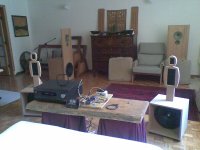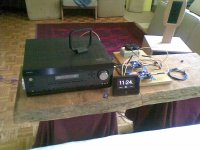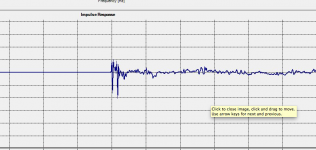David, I agree, don't give up at all.
DIY is a journey, not a quick fix.
I think the crossovers in OB, as Mr. Pass pointed out to me, is the hardest thing to get figured out for ob systems.
I also think drivers take a lot of time to break in.
Also amps and even the MiniDSP.
Bill Gaw, a local audio blogger for enjoythemusic, who I've listened to his scary system, had a couple of acoustic engineers come in to help optimize the response, to flatten it.
He hated it. Too much high, lost his mid range enjoyment.
DIY is a journey, not a quick fix.
I think the crossovers in OB, as Mr. Pass pointed out to me, is the hardest thing to get figured out for ob systems.
I also think drivers take a lot of time to break in.
Also amps and even the MiniDSP.
Bill Gaw, a local audio blogger for enjoythemusic, who I've listened to his scary system, had a couple of acoustic engineers come in to help optimize the response, to flatten it.
He hated it. Too much high, lost his mid range enjoyment.
Last edited:
Thats what every DIY builder does make a image about how they will sound when they are ready. In your case upgraded sound of what you have with the first OB.
I know the feeling when listening the first time. It is all about a good tonal balance. The new design has al ingredients to make a state of the art sound reproduction. Listen more songs not only the ones that sounded good on the first OB.
Most people like the added higher harmonics of a bad amp or speaker. When they hear clean undistorted sound they mis the humming lows and the whizzing highs.
As I look at the karakteristic of your new OB I would lift the lows till 30Hz and 2-3db louder than the mids. Your tweeter in your old design has a increase of 10dB around 10kHz and certainly that is a big difference with a flat response. A speaker with flat response like I have my self now sound really like life when played on the higher levels when I play mine on normal level I mis freshnes the effect caused by your sensitivety of your ears.
So your first OB tweeter lifts the high frequency like a loudness curve. I measured a pair magnepans OB they had also 10dB increase of loudnes below 150Hz to 30Hz. And also above 50khz there was lift in Spl of 10dB. Sounded great to my ears only the 30hz was some time to loud boomy.
Sensetivety when the line go up the loudness has to be increased to expirence the same levels with 1kHz.
An externally hosted image should be here but it was not working when we last tested it.
Thank you
I did some more listening last night and there not as bad as I first thought.
I did hear or feel some bass that I hadn't heard before. I played a large selection & the biggest problem was in the high end of female voices, they sounded shrieking, which made me want to turn the music down, where on other, mainly lower frequency music, I wanted to turn it up because it was so good.
I agree with you thoughts on lifting the lows & will make those changes. The old tweeters are best described by saying they where like honey, they sounded good, but I always felt they needed more brightness. I definitely don't think I need raise the high's, maybe lower them a bit.
I have recently read (SL) where a progressive lowering the mid/higher frequencies can settle things down on the shrieking front.
I think I have warn myself out for the moment, so will spent a bit of time listening before making any changes.
I am applying digital attenuation to level the drivers, which I have also read is not the best way to go, so I will look at applying driver levelling attenuation at the output with a trim pot or some such thing.
Have a great new year
David
David, I agree, don't give up at all.
DIY is a journey, not a quick fix.
I think the crossovers in OB, as Mr. Pass pointed out to me, is the hardest thing to get figured out for ob systems.
I also think drivers take a lot of time to break in.
Also amps and even the MiniDSP.
Bill Gaw, a local audio blogger for enjoythemusic, who I've listened to his scary system, had a couple of acoustic engineers come in to help optimize the response, to flatten it.
He hated it. Too much high, lost his mid range enjoyment.
Thanks for the encouragement, I will rest & then soldier on🙂
David
I would move them closer to the wall. 3-4 ft, or 1-1.5 meters.
Then they will be way to far from my bed, which is where I do my listening😀
discribe what you hear/do not hear with the new openbaffle.
I do mls measurements with microphone on listening position and both speakers reproducing the same mls signal, to see if the room has filtered out or lifted a part of the frequency band.
Now the real part of speaker building begins solving your problems with the sound.
I do mls measurements with microphone on listening position and both speakers reproducing the same mls signal, to see if the room has filtered out or lifted a part of the frequency band.
Now the real part of speaker building begins solving your problems with the sound.
Last edited:
discribe what you hear/do not hear with the new openbaffle.
I do mls measurements with microphone on listening position and both speakers reproducing the same mls signal, to see if the room has filtered out or lifted a part of the frequency band.
Now the real part of speaker building begins solving your problems with the sound.
Whats mls?
I will do the listening position measurements tomorrow. I made some changes to the crossover & have tried to lower the higher frequencies they were too pronounced for my liking. I haven't had a listen yet.
Somebody suggested I try reversing the polarity on the bass, which I tried & it got rid of the dip at the crossover🙂
I'm not good at describing things but I will give it my best shoot tomorrow after some more evaluation.
Better get evaluating then.
David
Then they will be way to far from my bed, which is where I do my listening😀
Turn it up louder then. That's what I do. My family resents me for it.
But you've got to learn to love yourself first, right?
Thank you
I did some more listening last night and there not as bad as I first thought.
I did hear or feel some bass that I hadn't heard before. I played a large selection & the biggest problem was in the high end of female voices, they sounded shrieking, which made me want to turn the music down, where on other, mainly lower frequency music, I wanted to turn it up because it was so good.
I agree with you thoughts on lifting the lows & will make those changes. The old tweeters are best described by saying they where like honey, they sounded good, but I always felt they needed more brightness. I definitely don't think I need raise the high's, maybe lower them a bit.
I have recently read (SL) where a progressive lowering the mid/higher frequencies can settle things down on the shrieking front.
I think I have warn myself out for the moment, so will spent a bit of time listening before making any changes.
I am applying digital attenuation to level the drivers, which I have also read is not the best way to go, so I will look at applying driver levelling attenuation at the output with a trim pot or some such thing.
Have a great new year
David
Looking great David!
Be patient... I found that it took some time for my brain to adjust to new speakers to fully understand and appreciate new speakers. Perhaps your old speakers have taught you some habits that will take a while to unlearn. 🙂
I think you may enjoy a small dip in SPL at 3.5 - 4khz (ie. BBC dip). I found this little tweak made female vocals sound much more realistic and less "shrieking" as you say.
I would also echo Helmut's suggestion that you may also enjoy at least 3db more output from woofer compared to midrange. I would suggest that even more than that may not be unreasonable at the lowest frequencies.
I also prefer the balance suggested by SL with approximately 1db/decade reduction toward the high frequencies, particularly when listening at higher volumes... not so much when listening very quietly.
cheers,
Josh
Holy Mother of ???
Boy did I get a surprise, but first some background.
I have been playing around with the crossover & EQ for a couple of days but was never really happy with the level of the high mids & highs, too much of both. I had basically been doing the measuring with one speaker, in the measuring position, in the middle of the room. then moving it back & listening in the listening position.
Yesterday the ex came over & I played the fourth Movement of William Russo's Street Music, Gondwanaland "Emu" & some Eva Cassidy to her & she was blown away, couldn't believe how good they sounded, but I wasn't happy, mids & high's you know.
I spent some more time trying to tame the mids & highs, then set them up for a listen when I went to bed, well I lasted about 10 minutes & turned them off in disgust.
Today I though I would follow Helmuth advice & measure from the listening position, WELL, my reasonably flat line had turned into a mountain range.
In the graphs below I show the: all measurements 1/12 Smoothed
I know it still looks like a mountain range, but that's more to do with the room etc. I tried to play with the major humps & hollows but it was like trying to move a mountain & in the end I didn't think things where going to get much better with EQ.
All through this, I will say, the speakers have a sound stage that seems to extend past there width, the musicians are well positioned, you can follow the pianist up & down the keyboard (to some degree), you can tell who's in the front & who's in the back & the harmonica that Corky Seigel plays in Street music put chills down my spine.
I will listen some more tonight I'm sure I'm not there yet. Oh yes the mid,s & high's have been tamed.
David
Boy did I get a surprise, but first some background.
I have been playing around with the crossover & EQ for a couple of days but was never really happy with the level of the high mids & highs, too much of both. I had basically been doing the measuring with one speaker, in the measuring position, in the middle of the room. then moving it back & listening in the listening position.
Yesterday the ex came over & I played the fourth Movement of William Russo's Street Music, Gondwanaland "Emu" & some Eva Cassidy to her & she was blown away, couldn't believe how good they sounded, but I wasn't happy, mids & high's you know.
I spent some more time trying to tame the mids & highs, then set them up for a listen when I went to bed, well I lasted about 10 minutes & turned them off in disgust.
Today I though I would follow Helmuth advice & measure from the listening position, WELL, my reasonably flat line had turned into a mountain range.
In the graphs below I show the: all measurements 1/12 Smoothed
- P17 in listening position, this measurement was taken some time ago & remember these are the speakers I like so much. (My Original Speakers)
- The final EQ done in the measuring position, one speaker
- The final EQ measured in the listening position, both speakers
- The last adjustment,
I know it still looks like a mountain range, but that's more to do with the room etc. I tried to play with the major humps & hollows but it was like trying to move a mountain & in the end I didn't think things where going to get much better with EQ.
All through this, I will say, the speakers have a sound stage that seems to extend past there width, the musicians are well positioned, you can follow the pianist up & down the keyboard (to some degree), you can tell who's in the front & who's in the back & the harmonica that Corky Seigel plays in Street music put chills down my spine.
I will listen some more tonight I'm sure I'm not there yet. Oh yes the mid,s & high's have been tamed.
David
Attachments
-
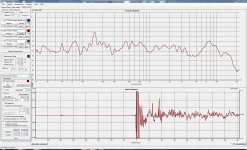 11-01-02 Both P17 at Bed Listening position.JPG413.1 KB · Views: 524
11-01-02 Both P17 at Bed Listening position.JPG413.1 KB · Views: 524 -
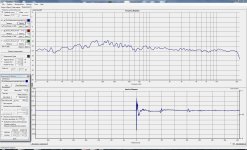 11-01-02 Final Measurement for 1st Jan tried to lower Highs etc.JPG419 KB · Views: 500
11-01-02 Final Measurement for 1st Jan tried to lower Highs etc.JPG419 KB · Views: 500 -
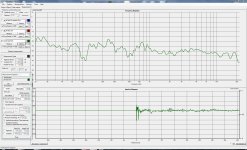 11-01-02 Starting point at listening position.JPG419.2 KB · Views: 484
11-01-02 Starting point at listening position.JPG419.2 KB · Views: 484 -
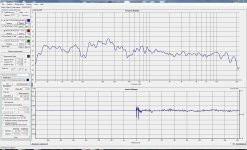 11-01-02 The One at listening position 1-12 smoothed.JPG423.4 KB · Views: 462
11-01-02 The One at listening position 1-12 smoothed.JPG423.4 KB · Views: 462
Last edited:
Hi david ,Today I though I would follow Helmuth advice & measure from the listening position, WELL, my reasonably flat line had turned into a mountain range.
David
Good to hear it begins to work for you may be you self begin to play-in with the new speakers.😀
But I can see at the impulse response your two channel measurements can be better. On the impulse response you can see both speakers weren't at the same distance from the microphone.
This difference is about 10 msec in your graphic. So the path difference from speaker to microphone is about 3meter. Both impulse responses shout lay over each other it will take some measurements to tune to positions till it is precise right. But you can see at the impulse response you are coming close. And you can use a cord of the same length from mic to speaker 1 and 2.
Look at the attachment you see two impulse responses. These shout be laying over each other. There for you need to position the speaker with in half a centimeter to measure the good value.
(3,5cm is 10kHz 1,5cm is 20kHz) so 0,75cm difference is opposite phase of the 20khz
Attachments
Last edited:
Hi david ,
Good to hear it begins to work for you may be you self begin to play-in with the new speakers.😀
But I can see at the impulse response your two channel measurements can be better. On the impulse response you can see both speakers weren't at the same distance from the microphone.
This difference is about 10 msec in your graphic. So the path difference from speaker to microphone is about 3meter. Both impulse responses shout lay over each other it will take some measurements to tune to positions till it is precise right. But you can see at the impulse response you are coming close. And you can use a cord of the same length from mic to speaker 1 and 2.
Look at the attachment you see two impulse responses. These shout be laying over each other. There for you need to position the speaker with in half a centimeter to measure the good value.
(3,5cm is 10kHz 1,5cm is 20kHz) so 0,75cm difference is opposite phase of the 20khz
I'm happy to report that the graph is in cm not msec 🙂, one of them would have been outside or in the next room if they where 3m out, so it's about 10cm, which I can understand. I have learn something, again thanks, will try the adjustment tomorrow.
It's hard to stop fiddling, I'm already planning the next tinker.
David
Congratulations on a very interesting speaker project! I've just read your thread end to end and I see you've learnt a great deal in doing this project.
I found with my open baffles that a flat response is quite undesirable and unpleasant. A drooping response starting highest in the midbass and quietest at about 5khz seems to be best (above there I think it's less important as there's v little fundamental musical info so high up).
It's a shame I didn't see your thread earlier, as I'd have happily given my opinions on how much bass is enough. For me, a passive 3 way system using 2 x 12" woofers (v cheap and low Xmax, mid-Q) has stunning bass at 40hz. I don't know if my tiny room is a plus or a problem, it just works!
Anyway, great thread and please do keep us informed of any further progressions in this design.
Regards,
Simon
I found with my open baffles that a flat response is quite undesirable and unpleasant. A drooping response starting highest in the midbass and quietest at about 5khz seems to be best (above there I think it's less important as there's v little fundamental musical info so high up).
It's a shame I didn't see your thread earlier, as I'd have happily given my opinions on how much bass is enough. For me, a passive 3 way system using 2 x 12" woofers (v cheap and low Xmax, mid-Q) has stunning bass at 40hz. I don't know if my tiny room is a plus or a problem, it just works!
Anyway, great thread and please do keep us informed of any further progressions in this design.
Regards,
Simon
Congratulations on a very interesting speaker project! I've just read your thread end to end and I see you've learnt a great deal in doing this project.
I found with my open baffles that a flat response is quite undesirable and unpleasant. A drooping response starting highest in the midbass and quietest at about 5khz seems to be best (above there I think it's less important as there's v little fundamental musical info so high up).
It's a shame I didn't see your thread earlier, as I'd have happily given my opinions on how much bass is enough. For me, a passive 3 way system using 2 x 12" woofers (v cheap and low Xmax, mid-Q) has stunning bass at 40hz. I don't know if my tiny room is a plus or a problem, it just works!
Anyway, great thread and please do keep us informed of any further progressions in this design.
Regards,
Simon
Thanks for your interest & input, always appreciated.
David
I think for the moment I am happy.
My Coldamp modules should arrive in the coming weeks, so that will be my next adventure. Almost forgot, I need to put the MiniDSP in a case of some sort as well.
Then I will need to start looking at building the final version of the speakers.
It has been suggested a couple of times that I should decouple the Mid-tweeter from the bass driver. I think this is probably a good idea but not that easy to do & still keep the design intact. I have a couple of ideas that I would like to run by you guy's in the coming days.
David
My Coldamp modules should arrive in the coming weeks, so that will be my next adventure. Almost forgot, I need to put the MiniDSP in a case of some sort as well.
Then I will need to start looking at building the final version of the speakers.
It has been suggested a couple of times that I should decouple the Mid-tweeter from the bass driver. I think this is probably a good idea but not that easy to do & still keep the design intact. I have a couple of ideas that I would like to run by you guy's in the coming days.
David
Linkwitz got good gains decoupling the Seas Excel mid from his Orion baffle. That design offers good inspiration, though it's a conventional-shaped driver.
What material are you making your final baffles from?
What material are you making your final baffles from?
Linkwitz got good gains decoupling the Seas Excel mid from his Orion baffle. That design offers good inspiration, though it's a conventional-shaped driver.
What material are you making your final baffles from?
The baffles, what there is of them, will probably be made of Tasmanian Blackwood Rich Tasmanian Blackwood Or possibly something harder, not sure yet.
The "H" frame will be made of 25'' MDF.
David
I think for the moment I am happy.
It has been suggested a couple of times that I should decouple the Mid-tweeter from the bass driver. I think this is probably a good idea but not that easy to do & still keep the design intact. I have a couple of ideas that I would like to run by you guy's in the coming days.
David
An idea for you: Picture your "Man" but rather than standing on the subwoofer, maybe he would be "swinging". 😀
- Status
- Not open for further replies.
- Home
- Loudspeakers
- Multi-Way
- OB Project Design Started, Help Requested.
